Limoniinae
The Limoniinae are a paraphyletic assemblage of genera within the crane flies, Tipulidae, although they can usually be distinguished by the way the wings are held at rest. Limoniines usually hold/fold the wings along the back of the body, whereas other tipulids usually hold them out at right angles. Snow flies (genus: Chionea) such as Chionea scita have no wings at all. Limoniines are also usually smaller than other tipulids, with some exceptions. Limoniinae are a very large assemblage with nearly 10500 described species in 133 genera, and were historically treated as a subfamily, but their classification is in flux; numerous authors recently treated the group at the rank of family, but subsequent phylogenetic analyses revealed that the remaining groups of tipulids render the group paraphyletic.[1] These flies are found in damp places throughout the world, and many species form dense swarms in suitable habitats.
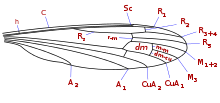
.svg.png)
| Limoniinae | |
|---|---|
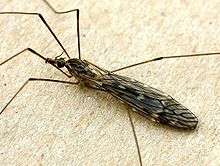 | |
| Limonia nubeculosa | |
| Scientific classification | |
| Kingdom: | |
| Phylum: | |
| Class: | |
| Order: | |
| Suborder: | |
| Infraorder: | |
| Superfamily: | |
| Family: | |
| Subfamily: | Limoniinae |
| Genera | |
|
see text | |
| Diversity | |
| ca. 150 genera | |
Description
For terms see Morphology of Diptera
Limoniines are medium or small-sized, rarely large. The proboscis or rostrum lacks a beak. The apical segment of the maxillary palpi is short and never longer than subapical one. The antennae are, in most species, 14- or 16-segmented (rarely 6-, 10-, or 17-segmented), usually verticillate (whorls of trichia) and only exceptionally ctenidial or serrate (Rhipidia). There is a distinct V-shaped suture between the mesonotal prescutum and scutum (near the level of the wing bases). The wings are monochromatic or punctate and (in females more often than in males). sometimes shortened or reduced. The subcosta always fuses with the costa through Sc1. Radial vein R2 does not fuse with the costa, as in most other Tipulidae, but with radial vein R3. The radial sector Rs has one or two forks.Additional crossveins are sometimes present in cells r3 an1 and m. Cells m1 and d often not present. The genitalia of males have large separated gonocoxis and one or two pairs of appendages which are sometimes greatly folded (Dicranomyia, etc.). The ovipositor of the female has sclerotized cerci.
Biology
Mostly, larvae are aquatic or semi-aquatic. Most other Tipulidae larvae in comparison, are terrestrial though some are aquatic and found in huge numbers in lotic habitats like the limoniine larvae. Various species have evolved to feed on different food sources, so phytophagous, saprophagous, mycetophagous and predatory species occur.
Limoniines occupy a wide range of habitats and micro habitats: in earth rich in humus, in swamps and marshes, in leaf litter and in wet spots in woods (numerous genera and species; in soils with only moderate humus content along stream borders (Gonomyia Meigen, Rhabdomastix Skuse, Arctoconopa Alexander, Hesperoconopa Alexander); in dry to saturated decaying wood in streams, where the larvae feed on fungal mycelia (Gnophomyia Osten Sacken, Teucholabis Osten Sacken, Lipsothrix Loew); in decaying plant materials (various subgenera and species of Limonia),in woody and fleshy fungi (Limonia (Metalimnobia Matsumura); in fresh water, especially rapidly flowing streams (Antocha Osten Sacken, Hesperoconopa Alexander, Cryptolabis Osten Sacken); intertidal zones and brackish water (Limonia (Idioglochina Alexander, Limonia (Diuanomyia) Stephens) ; freshwater aquatic environment during the larval stage and nearby margin areas for pupation (Limonia Meigen, Thaumastoptera Mik, many Pediciini, Hexatomini, and Eriopterini); steep cliff faces supporting a constantly wet film of algae (some species of Limonia Meigen, Orimarga Osten Sacken Elliptera Schiner); in moist to wet cushions of mosses or liverworts growing on rocks or earth (various species).[2][3]
Species lists
Evolution
Limoniines are not particularly common in amber deposits, but a few finds (e.g. Tipunia intermedia Krzeminski & Ansorge, 1995 from the Upper Jurassic Solnhofen limestones) suggest the family has been extant since the Jurassic period.
Gallery

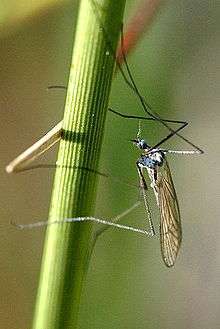

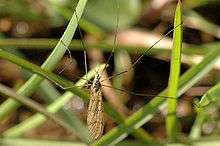


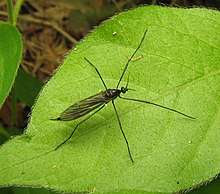
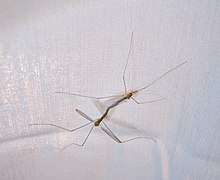 Antocha saxicola mating
Antocha saxicola mating
See also
List of limoniid genera
References
- Petersen, M.J.; Bertone, M.A.; Wiegmann, B.M.; Courtney, G.W. 2010: Phylogenetic synthesis of morphological and molecular data reveals new insights into the higher-level classification of Tipuloidea (Diptera). Systematic entomology, 35: 526-545. doi: 10.1111/j.1365-3113.2010.00524.x
- Alexander C.P., Byers G.W. (1981) Tipulidae. in: McAlpine J.F. et al. (Ed.), Manual of Nearctic Diptera. Agriculture Canada, Ottawa, pp. 153–1902 ISBN 0660107317 pdf Archived 2013-12-01 at the Wayback Machine download manual
- Ujvarosi, L., Poti T., 2006: Studies on the community structure of the Tipuloidea (Insecta, Diptera) assamblages of the După Luncă Marsh, Eastern Carpathians. Acta Biol. Debr. Oecol. Hung. 14: 253-262 pdf Archived 2014-01-16 at the Wayback Machine
- Description, ranked as family
- Catalogue of the crane flies of the world
- Fossil Diptera catalog
- Diptera.info Images
- Limoniidae at EOL images
| Wikimedia Commons has media related to Limoniidae. |